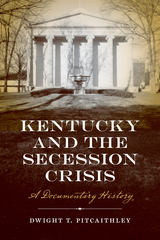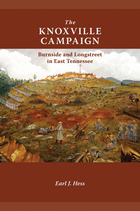7 start with K start with K

A slave state itself but bordering three non-slave-state neighbors across the Ohio River, Kentucky was in a difficult position as division swept the country. Aware that secession would nullify the Fugitive Slave Act and believing that slavery as a statewide institution would be better protected if Kentucky remained in the Union, the Bluegrass State ultimately stepped away from its Deep South sister states and chose not to secede. Kentucky and the Secession Crisis: A Documentary History showcases the discourse that followed the 1860 election and sheds light on Kentucky’s political thought processes as the state struggled toward a decision.
This important collection includes addresses by Governor Beriah Magoffin; Senator John J. Crittenden’s December 1860 address proposing a Constitutional solution to secession; speeches by various proponents and opponents of the Crittenden amendment; various Constitutional amendments proposed by Kentuckians; and documents related to the second session of the Thirty-Sixth Congress, the Washington Peace Conference of 1861, and the Border Slave State Conference. With a lengthy introduction and questions for discussion, Kentucky and the Secession Crisis is an insightful and valuable resource for historians as well as for the classroom.


Born 130 years ago in the heart of Mississippi, Charlie Patton (c. 1891–1934) is considered by many to be a father of the Delta blues. With his bullish baritone voice and his fluid slide guitar touch, Patton established songs like “Pony Blues,” “A Spoonful Blues,” and “High Water Everywhere” in the blues lexicon and, through his imitators, in American music. But over the decades, his contributions to blues music have been overshadowed in popularity by those of Robert Johnson, Muddy Waters, and other mid-century bluesmen and women who’ve experienced a resurgence in their music. King of the Delta Blues Singers, originally published in 1988, began a small renaissance in blues and Patton research and set a new scholarly precedent touching even the spelling his name—which, to Patton himself, was "Charlie," not the "Charley" of the early records. And now, with the wide availability of Patton’s complete discography in multiple formats, this revised second edition brings the legend of Charlie Patton into a clarity of detail that was previously impossible.
Gayle Dean Wardlow and the late Stephen Calt (1946–2010) originally probed Patton’s career in the Mississippi Delta, his early performances and recordings, and his musical legacy that continues to influence today’s guitarists and performers, including such musicians as Jack White and Larkin Poe. For this second edition, Wardlow and Edward Komara refined the text and rewrote major sections, updating them with new scholarship on Patton and Delta blues. And finally, Komara has added a new afterword bringing Patton into the contemporary blues conversation and introducing numerous musical examples for the modern researcher and musician.
The second edition of King of the Delta Blues Singers will further cement Patton’s legacy among important blues musicians, and it will be of interest to anyone absorbed in the beginnings of the Delta blues and music biographies.

In the fall and winter of 1863, Union General Ambrose Burnside and Confederate General James Longstreet vied for control of the city of Knoxville and with it the railroad that linked the Confederacy east and west. The generals and their men competed, too, for the hearts and minds of the people of East Tennessee. Often overshadowed by the fighting at Chickamauga and Chattanooga, this important campaign has never received a full scholarly treatment. In this landmark book, award-winning historian Earl J. Hess fills a gap in Civil War scholarship—a timely contribution that coincides with and commemorates the sesquicentennial of the Civil War
The East Tennessee campaign was an important part of the war in the West. It brought the conflict to Knoxville in a devastating way, forcing the Union defenders to endure two weeks of siege in worsening winter conditions. The besieging Confederates suffered equally from supply shortages, while the civilian population was caught in the middle and the town itself suffered widespread destruction. The campaign culminated in the famed attack on Fort Sanders early on the morning of November 29, 1863. The bloody repulse of Longstreet’s veterans that morning contributed significantly to the unraveling of Confederate hopes in the Western theater of operations.
Hess’s compelling account is filled with numerous maps and images that enhance the reader’s understanding of this vital campaign that tested the heart of East Tennessee. The author’s narrative and analysis will appeal to a broad audience, including general readers, seasoned scholars, and new students of Tennessee and Civil War history. The Knoxville Campaign will thoroughly reorient our view of the war as it played out in the mountains and valleys of East Tennessee.
EARL J. HESS is Stewart W. McClelland Distinguished Professor in Humanities and an associate professor of history at Lincoln Memorial University. He is the author of nearly twenty books, including The Civil War in the West—Victory and Defeat from the Appalachians to the Mississippi and Lincoln Memorial University and the Shaping of Appalachia.


This third edition of Knoxville, Tennessee: A Mountain City in the New South includes a new preface and a valuable new chapter covering the period from the death of Cas Walker to the end of the administration of Madeline Rogero, Knoxville’s first female mayor.
Wheeler argues that, until very recently, like Jay Gatsby in The Great Gatsby (1925), Knoxvillians had fabricated for themselves a false history, portraying themselves and their city as the almost impotent victims of historical forces that they could neither alter nor control. The result of this myth has been a collective mentality of near-helplessness against the powerful forces of isolation, poverty, and even change itself. But Knoxville’s past is far more complicated than that, for the city contained abundant material goods and human talent that could have been used to propel Knoxville into the ranks of the premier cities of the New South—if those assets had not slipped through the fingers of both the leaders and the populace. In all, Knoxville’s history is the story of colliding forces—country and city, North and South, the poor and the elites as well as the story of colorful figures, including Perez Dickenson, Edward Sanford, George Dempster, Carlene Malone, Bill Haslam, and Madeline Rogero, among many, many more.
While challenges related to public health, income inequality, racism, and the environment remain, Wheeler detects the possibility that the myth Knoxvillians have clung to may finally be fading. Downtown development by vibrant local entrepreneurs, a government more responsive than ever before, and an economy that endured a severe economic downturn only to turn out brighter than expected are all symptoms of a Knoxville that may be ready to take its place in the rising urbanism of twenty-first-century America.

READERS
Browse our collection.
PUBLISHERS
See BiblioVault's publisher services.
STUDENT SERVICES
Files for college accessibility offices.
UChicago Accessibility Resources
home | accessibility | search | about | contact us
BiblioVault ® 2001 - 2024
The University of Chicago Press









